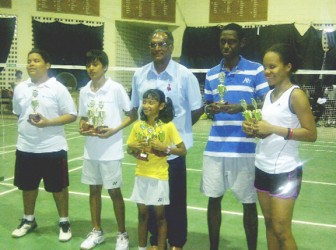By Iva Wharton
Significant growth and development in badminton is being prevented because there is no facility available for training and tournaments, says Gokarn Ramdhani, President of the Guyana Badminton Association (GBA).
Ramdhani in an interview with Stabroek Sport on Monday, said that the GBA was unable to increase its membership because of the absence of a facility which can be used for training and tournaments.
Training and tournament play are critical requirements for the development of a viable and successful sport, he opined.

He said, however, that the association was working towards the construction of its own building.
“Since three years ago we have located the finances but getting the right piece of land in the right area is the problem because you cannot put it some place that is too far that you cannot attract the people that you will want to come and play. So we are hoping sooner or later at the Racquet Center…. I hope that they will put down a building where we could use, like what they did for squash and lawn tennis.”
According to Ramdhani, it would cost the association between $80M to $100M to build the facility. He said the association was working with a major sponsor but declined to reveal the sponsor’s name.
“Badminton requires a facility that is 30 feet minimum in height to play and, other than Queen’s College, the only place is the Cliff Anderson Sports Hall. So all the other places that play badminton are basically handicapped.”

That, he said, was one of the reasons that there is no rush to increase membership. According to Ramdhani, it makes no sense for the association to increase the membership without having a facility to train.
He said while Queen’s College is accessible, it is not always available. He also said that the concrete surface is not an ideal place to practice as the players would eventually need rubberized flooring.
Extra lessons
Another factor he identified as hampering the expansion of the sport is the time being spent on ‘extra lessons’ by so many potential players. Ramhdani said that in many instances players have shorter practice sessions as a result and some even drop the sport entirely when they reach a certain age. He also said that those attending university also drop the sport because of late classes.
“So, that is killing the sport, while the rest migrate.”
Asked about the decentralization of the sport, Ramdhani said that the association has been able to restart the sport in Berbice. He noted also that:”We also went into the schools, both primary and secondary schools, and made donations of racquets and nets.”
Ramdhani said that it is his hope that the donations are not tucked into a corner but are utilized. He admitted that the challenges they face with such programmes is the lack of human resources to do follow-up interventions.
“Although we did the demos and those things, there is nobody that is following it up. So what we may have to do in the future is invite Physical Education teachers from schools to do maybe a crash course and they can take it from there.”
He said that with his schedule he is stretched thin, but said that training programmes would be done. According to the GBA president, he teaches badminton voluntarily at Marian Academy where there are a number of students who can assist in developing the sport.
“Also we run the Yonex Badminton Club which is open to anyone and there is also the Queen’s College Club.”
What the association has been able to do successfully is to move the stronger players from Marian to Yonex where they are prepared for tournaments.
Yonex Badminton Club is the oldest club currently registered with the GBA, and it has a history that dates back to the seventies.
Ramdhani became president of the club in 1983. The other two clubs affiliated to the association are at Queen’s College and Marion Academy. There is also a group of men involved in the sport, but they have not formed themselves into a club. In fact, there are only three clubs affiliated to the association, Ramdhani noted.
Asked about the participation of persons from the mining town of Linden, Ramdhani said there is neither a club existing there nor any badminton training.
“That is where some of our best national players actually came from in the eighties; it was very nice in those days.”
According to him, he is disappointed that fellow badminton players from his era have failed to lend assistance with the development of the sport.
“This is one of the things that I am disappointed with! That our ex-national players who came out from different schools like Bishops’ and Saints should lend their time at least one hour in the afternoon to put back something into the sport.”
He said that even though many of the players have migrated, others are still here. Ramdhani pointed out that the association needs all the assistance it can get to push the sport forward and most of that support is needed in the area of coaching.
“So I got to do everything and it is impossible: look, I am doing Marion voluntarily, doing Yonex and helping QC out. Then I have to go to Berbice, but if I have some men who could have done that it would have been easier. But what I have is some very nice members of my association who behind the scenes back up very much.”
He said that the sport is pretty expensive but the association tries to minimize the cost. The shuttlecocks are not cheap, but the association tries to provide it for the players.
“The shuttlecock is $500 for one and a two best in three [tournament] use three shuttlecocks which is $1,500. Then the players have to get the right shoes with the grip and a shoe just above US$100, and then the racquet is just over US$100 also.” Speaking about the major accomplishments during his tenure which he said was close to 15 years, Ramdhani highlighted Guyana’s participation in the Pan American Badminton Championship.
Guyana, he said, has been participating in the championship for the past five years and has held the bronze title for the last two years consecutively.
“So all our preparation that we do right now all through the year is training for that tournament. We held the bronze medal two years in a row, last year and the year before.”
Currently in the region, Guyana is ranked number one at the under-11, number two in the under-13 and under-15 categories, which, according to Ramhdani is a success given the constraints faced at home.
He identified some of the best players in the association as Nicholas Ali, Narayan Ramdhani, Greer Jackson, Avinash Odit and ten-year-old Priyanna Ramhdani.
The young Ms. Ramhdani is the Junior Sportsowmn of the Year and at the just concluded presentation ceremony for the Mashramani competition walked away with three first place trophies and a second place. She secured first place in the Under-11, U-13 and U-15 and was second in the U-17.
Other first place winners were Jonathan Mangra, U-13 boys; Narayan Ramdhani in the boys U– 15 and U-17; Greer Jackson in the girls U–17 and U-19 and Nicholas Ali in the boys U-19.





